Bulletin #2261, Forage Facts: Growing Forage Legumes in Maine
Bulletin #2261, Forage Facts: Growing Forage Legumes in Maine (PDF)
Developed by Timothy S. Griffin, Extension Sustainable Agriculture Specialist
For information about UMaine Extension programs and resources, visit extension.umaine.edu.
Find more of our publications and books at extension.umaine.edu/publications/.
Table of Contents:
- Alfalfa (Medicago sativa L.)
- Red Clover (Trifolium pratense L.)
- Ladino or White Clover (Trifolium repens L.)
- Alsike Clover (Trifolium hybridum L.)
- Birdsfoot Trefoil (Lotus corniculatus L.)
- Table 1. Rates for seeding legumes alone and in mixtures
- Table 2. Forage legumes at a glance
- VIDEO: How to Test Forage Quality (YouTube)
- VIDEO: How to Frost Seed (YouTube
- Acknowledgment
Livestock production in Maine, whether dairy, beef or sheep, depends on forage crops. Some forages are grown as hay, some as silage, and others are grazed. To get the most out of the forage crop, you need to know which forages are on your farm and how to manage them. This fact sheet summarizes the forage legumes that are most common to Maine: alfalfa, red clover, Ladino (white) clover, alsike clover, and birdsfoot trefoil. These legumes are usually grown with grasses in pastures and hayfields because they improve the quality of the forage (especially by increasing the protein content) and contribute nitrogen (N) to grasses grown with them.
All of the legumes discussed here are capable of taking nitrogen from the air and converting it to protein in the plant. Bacteria in root nodules carry out this nitrogen fixation process. To be sure that effective nodules form on these legumes, it is critical that seeds are inoculated with the right bacteria immediately before planting. Make sure that the inoculant is the right one for the legume you are planting; alfalfa inoculant is different than birdsfoot trefoil inoculant.
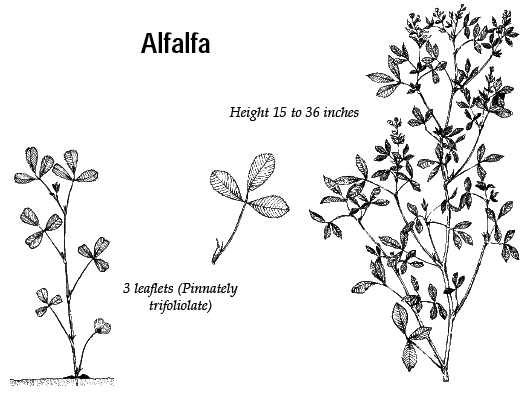 Alfalfa
Alfalfa
(Medicago sativa L.)
Growth Habit and Appearance: Alfalfa is a deep-rooted perennial legume that grows in bunches or clumps. Leaves are “trifoliolate.” This means that each leaf is actually three leaflets. The outer one-third of each leaflet is usually (but not always) serrated or rough. Flowers develop where leaves attach to the stem. They vary in color from white to yellow to purple.
Adaptation: Alfalfa is adapted to a wide range of climates. As a result, it is one of the few crops that is grown in every state. Because of its deep root system, established alfalfa is very drought tolerant; growth slows or stops during drought but starts again when water is available. Two factors limit the use of alfalfa in Maine: soil drainage and soil pH. Alfalfa does not produce high yields or survive very long on either poorly drained soils or acid (low pH) soils.
Productivity: Under ideal conditions, alfalfa is capable of producing more than 10 tons of hay per acre of high-quality forage. More often, yields range from three to five tons per acre. (Yield is very dependent on soil fertility.) Soil pH should be 6.5 to 7; pH below this level reduces the amount of N fixed by bacteria in the roots and shortens the life of the stand. Phosphorous (P), potassium (K) and lime should be added according to soil test results to maintain productive, long-lived stands. Phosphorous is very important for alfalfa root development, while potassium affects alfalfa winterhardiness.
Alfalfa-grass mixtures for hay or silage are the most common use of alfalfa in Maine and throughout New England. There are several reasons for this.
- The yield of alfalfa and grass together is usually greater than either planted alone.
- As the alfalfa stands thins out or dies, the grass can fill in the stand. This may mean fertilizing the grass with nitrogen, but at least there is still a forage crop available for harvest.
- The alfalfa-grass mixture can be grazed with less potential for bloat to occur.
In Maine, the two kinds of grass best adapted for use with alfalfa in a mixture are timothy and orchardgrass. Timothy should be seeded at 6 to 8 lb/acre, while the more aggressive orchardgrass should be seeded at less than 4 lb/acre.
Management Recommendations: Because of the soil drainage and pH requirements of alfalfa, we have some problems maintaining alfalfa stands in Maine (where we have wet, acid soils). There are several things that you can do to increase the stand life and the yield of alfalfa, whether it is planted alone or with a grass.
- When planning an alfalfa seeding, select the field with the best drainage on your farm.
- Take soil samples and fertilize according to soil test results. Pay particular attention to soil pH (6.5 or higher), P and K. If these are not adequate, both stand life and yield will be reduced.
- Select an improved alfalfa variety. Alfalfa diseases are not a big problem in Maine, so varieties are usually selected based on winterhardiness (“winterhardy” to “very winterhardy”) and yield potential. Although alfalfa variety tests are not conducted in Maine, information from other northern states (New York, Michigan, Minnesota) is available and very useful.
- Carefully plan the planting operation (type of planter, weed control, seeding rates of alfalfa and grass, etc.) to get the alfalfa well established before the first winter. Spring seedings with or without small grain companion crops should be done before June 1. Summer seedings without small grains should be done before August 1 (northern Maine) or August 10 (central and southern Maine).
Red Clover
(Trifolium pratense L.)
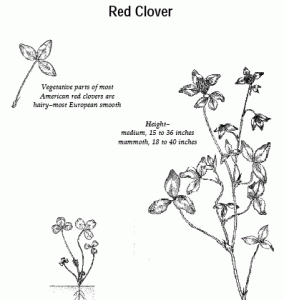 Growth Habit and Appearance: Red clover is a shallow-rooted perennial that usually acts as a biennial (it dies after two years). Leaves are trifoliolate, like alfalfa, with three large leaflets per leaf. The leaves commonly have a white or gray mark shaped like the letter “V.” Leaves and stems are covered with fine hair. Flowers are in clusters at the top of the plant and are dark pink to red in color.
Growth Habit and Appearance: Red clover is a shallow-rooted perennial that usually acts as a biennial (it dies after two years). Leaves are trifoliolate, like alfalfa, with three large leaflets per leaf. The leaves commonly have a white or gray mark shaped like the letter “V.” Leaves and stems are covered with fine hair. Flowers are in clusters at the top of the plant and are dark pink to red in color.
Adaptation: Grazing is preferred for mixed clover stands because red clover is difficult to dry for hay. The clover is added to increase the protein content of the forage. In Maine, red clover is most often seeded in a pasture with a grass like timothy on soils that are not good enough to grow alfalfa. These soils may be too wet for alfalfa or have a pH of around 6. Soil fertility should be maintained if you expect clover to contribute to total yield. Be aware that the seeding of red clover is a short-term solution; it dies after two years from a root-disease complex or feeding by a pest called the clover root curculio.
Productivity: The yield potential of red clover is near that of alfalfa for the first year, but winterkill usually thins the stand before the second production year. If red clover is grown for hay or silage, it is best suited to short crop rotation. In this way, some forage is harvested and the clover provides nitrogen for the following crop (like corn or potatoes). In pastures, individual red clover plants do not survive more than two years, which makes seeding of red clover questionable. Most pastures in Maine have enough naturally occurring clover (either red or white) that adjustments in soil pH, phosphorous and/or potassium will increase the proportion of clover in the forage.
Management Recommendations: Red clover can be seeded in several ways, depending on how the forage will be used. For pastures, red clover is commonly frost-seeded into existing grass pastures. This is done by broadcasting seed on frozen ground. The freezing and thawing will work the seed into the ground enough for the seed to germinate. For hayfields, clover should be seeded (with or without grass) the same way that alfalfa is seeded. The price of red clover seed has been approaching that of alfalfa in some areas, so plan your seeding. Red clovers are available for one-cut systems (‘Mammoth’). In addition, several improved varieties of red clover are available for multiple-cut systems. For example, ‘Arlington’ has been widely grown in New England and is still popular. ‘Marathon’ is a high-yielding, newer variety that may survive into the third year.
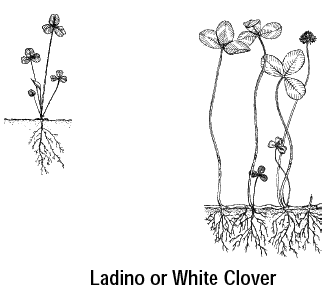 Ladino or White Clover
Ladino or White Clover
(Trifolium repens L.)
Growth Habit and Appearance: Ladino clover and white clover refer to the same plant species. Ladino clover is taller, leafier and higher-yielding than the wild type of white clover (which often grows in lawns). The leaves and stems of both are smooth, and they spread by stolons or creeping aboveground stems. Flowers are small clusters at the top of stems and are white to off-white in color.
Adaptation: The white clovers are shallow-rooted and don’t have a distinct taproot like alfalfa. This root system allows these clovers to survive in poorly drained soils, but survival may be difficult during drought or winters with little snow cover. Soil pH can be lower (5.5 to 6.5) than for red clover or alfalfa, but these clovers will also respond to higher soil pH.
Productivity and Management Recommendations: The yield of ladino clover is less than two-thirds that of red clover; white clover yield is lower still. The low yield potential and low, creeping growth habit of the white clover makes it suitable for pasture use but not hayfields. White clover occurs naturally in many pastures so seeding may be unnecessary. Growth can be encouraged by grazing management (especially rotational grazing) and improving soil fertility (soil pH, phosphorous and potassium).
Alsike Clover
(Trifolium hybridum L.)
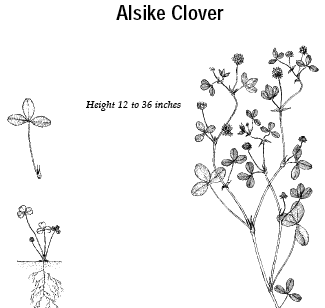 Growth Habit and Appearance: Alsike clover is a perennial clover that is a cross between red clover and white clover. In appearance, it has characteristics of both. It is somewhat upright with numerous branches. The leaves are smooth like white clover, and the leaflets are one-half to one inch in length but do not have the V-shaped mark like red clover. The flowers are similar to those of white clover but vary in color from nearly white to pink to nearly red.
Growth Habit and Appearance: Alsike clover is a perennial clover that is a cross between red clover and white clover. In appearance, it has characteristics of both. It is somewhat upright with numerous branches. The leaves are smooth like white clover, and the leaflets are one-half to one inch in length but do not have the V-shaped mark like red clover. The flowers are similar to those of white clover but vary in color from nearly white to pink to nearly red.
Adaptation: Alsike clover is very common in Maine because it is adapted to both cool climates and acid soils. It will also tolerate occasional flooding. Survival and yield of alsike clover will be low on dry soils or when temperatures are high.
Productivity and Management Recommendations: Many seeding mixtures sold in Maine contain some alsike clover seed, along with red clover. The alsike clover is included as “insurance” to fill in the areas that are too wet for red clover to survive. The yield of the alsike is much lower than for red clover or even birdsfoot trefoil. Like red clover, individual plants rarely live more than one or two years, but some natural reseeding will usually occur. Like the other clovers, alsike clover is acceptable feed for cattle when included in a grass pasture. However, pastures with alsike clover should not be used for horses. Chemicals in the plant can cause photosensitivity (sensitivity to sunlight), liver damage, and in rare cases death. Horses will avoid eating alsike clover but may do so if forage is in short supply.
Birdsfoot Trefoil
(Lotus corniculatus L.)
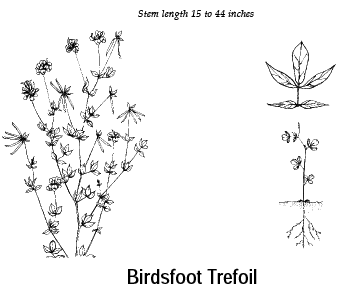 Growth Habit and Appearance: Birdsfoot trefoil is a low-growing perennial legume, with stems one to two feet long. Each leaf has five leaflets (instead of three like the clovers) and is smooth. Flowers are borne at the top of the plant and are bright yellow in color. Seed pods are dark brown and resemble a “bird’s foot.” There are two types of trefoil. One is “decumbant,” or low-growing. This type is best used in pastures. The other type is erect or upright. It is best suited for hay or silage production.
Growth Habit and Appearance: Birdsfoot trefoil is a low-growing perennial legume, with stems one to two feet long. Each leaf has five leaflets (instead of three like the clovers) and is smooth. Flowers are borne at the top of the plant and are bright yellow in color. Seed pods are dark brown and resemble a “bird’s foot.” There are two types of trefoil. One is “decumbant,” or low-growing. This type is best used in pastures. The other type is erect or upright. It is best suited for hay or silage production.
Adaptation: Birdsfoot trefoil is adapted to a wider range of soil conditions than any other forage legume. It will tolerate soil pH between 3.5 and 9, low soil fertility and poor soil drainage. Like most other plants, however, the yield is much higher on better drained, higher fertile soils. Under good management and fertility, it is also extremely long-lived; it can survive in some pastures for 50 years or more.
Productivity and Management Recommendations: The yield of birdsfoot trefoil is considerably less than alfalfa, but may equal that of red clover if fertility is high. It is a desirable legume in pastures, especially those that are difficult to seed, because of its long life span and because it does not cause bloat in grazing livestock. The type of trefoil grown should be based on how it will be used. Use the decumbant or low-growing type (‘Empire,’ for example) for pastures and the erect or upright type (‘Norcen’ and ‘Viking’) for hayfields.
Getting trefoil established in a pasture or hayfield can be difficult. This is the major reason why it is not seen often in Maine and New England. It does not compete well with weeds as a seedling (one to two months after seeding). It does poorly if it is shaded by weeds during this stage. Clear-seeding (without small grains) has the greatest chance of success. After trefoil is established, implement a harvest management plan. Trefoil should not be cut below six inches in the spring; a rotational grazing system is useful in managing harvest height.
Legumes usually don’t survive as long as grasses in a pasture or hayfield (except for birdsfoot trefoil). They can also be expensive to establish. For these reasons, it is important that you know why they should be in the pasture or hayfield, what benefit they will give you, and which legume is best suited for your needs. For more information about forage crops, contact your local UMaine Extension County Office.
Acknowledgment
The drawings were reproduced from Identification of Grasses and Legumes, Publication No. AG-30-S, University of Missouri-Columbia. Permission from the Instructional Materials Laboratory at the University of Missouri-Columbia and from Mrs. H.B. Hartwig.
Information in this publication is provided purely for educational purposes. No responsibility is assumed for any problems associated with the use of products or services mentioned. No endorsement of products or companies is intended, nor is criticism of unnamed products or companies implied.
© 2004
Call 800.287.0274 (in Maine), or 207.581.3188, for information on publications and program offerings from University of Maine Cooperative Extension, or visit extension.umaine.edu.
The University of Maine is an EEO/AA employer, and does not discriminate on the grounds of race, color, religion, sex, sexual orientation, transgender status, gender expression, national origin, citizenship status, age, disability, genetic information or veteran’s status in employment, education, and all other programs and activities. The following person has been designated to handle inquiries regarding non-discrimination policies: Director of Equal Opportunity, 101 North Stevens Hall, University of Maine, Orono, ME 04469-5754, 207.581.1226, TTY 711 (Maine Relay System).

